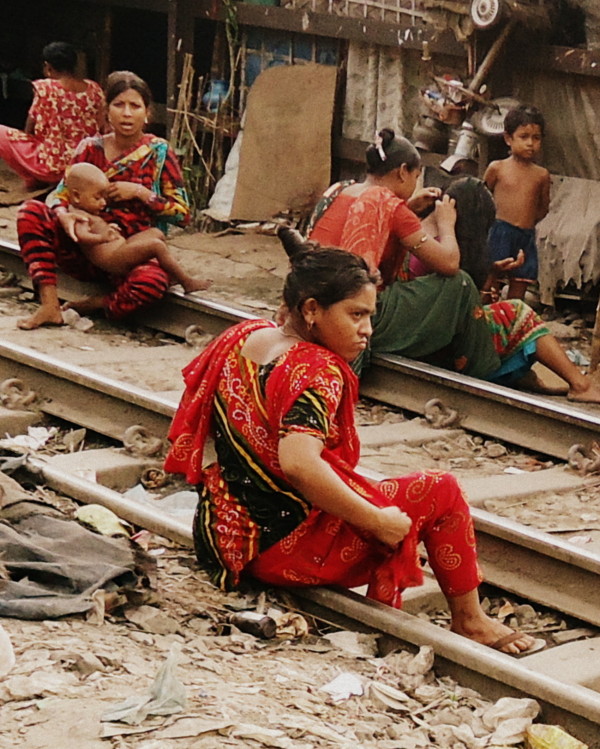The concentration of public health issues and adverse environmental circumstances in slums are increasingly important concerns for developing countries like Bangladesh. This country has experienced a steady growth in its urban population, most particularly in the capital city, Dhaka, ever since independence in 1971.This city-effect has triggered a rapid urbanization across Bangladesh coupled with rapid slumization and environmental degradation, health risks and much more.
By Shidratul Moontaha Suha*
Clearly, these slums in Dhaka city where public health facilities, water and sanitation services, are almost non-existent, result in various kind of diseases. This means poor health for the millions making up the slum populations, and it especially affects adolescent girls.
‘Environmental Health’ (EH) as a term is not easy to define. This gives rise to the thought that, referring to the ‘health of the environment’ might be possible without reference to a particular species i.e. Homo sapiens. Even if one wanted to define the term with special reference to human health – as generally used, this still leaves plenty of room for debate. Thus, EH is a branch of public health concerned with all aspects of the natural and built environment that may affect human health.
Failure of adolescent development is the result of preventable environmental health risk behaviours in urban slums. Poor hygiene, poor sanitation facilities, crowded and damp housing conditions, inadequate supply of safe drinking water, unhygienic drainage systems and improper disposal of excreta are common problems among the residents of slum settlements in Dhaka City.
It is easily assumed then that the poor social services (e.g. Community based health education) with no health care facilities, lack of privacy and safety in using toilet and washing facilities leads adolescent girls into the statistics of poor nutrition and stunted growth. Side-by-side, improper waste management creates outdoor air pollution.
Again, insecure sleeping arrangements with a congested living style and without ventilation together creates indoor air pollution. Collectively, all these aggravate respiratory tract infections and diseases among adolescent girls (e.g. Bronchial, Asthma and skin diseases like Scabies, Ring-worm) are also more frequent among this group.
Due to lack of environmental health education, married adolescent girls may face vaginal itching, infections of the urinary tract and perineum, pelvic inflammatory diseases, leucosis and many other health hazards. All these produce negative reproductive health (NRH) outcomes. The problem is exacerbated due to difficult life experiences which reflects badly on their well-being, hampering their functioning and thus resulting in the loss of any future capabilities demanding exercise of their senses, imagination and thinking. As they lack playgrounds, therefore they have no access to meet physical exercise needs, have no freedom of choice to play, this in practice renders them unable to control their own life environment.
According to WHO, where people live affects their health and life outcomes. This means impoverished people’s health is especially determined by whether they live in an urban or rural area. Living situations are especially strong determinants of health in situations of poverty. Poverty means slum living adolescent girls’ first need to eat for survival itself, but the lack of knowledge is also a matter of concern. Poor diet and thus nutrition is very common among adolescent girls living in slums, as could be expected, and the health issue of adolescents have been given due importance when it comers to their nutrition. But that is not enough.
Depression from sexual assault can change the way an adolescent girl sees herself, also how she sees the lives of the people around her. They often see everything more negatively. They cannot imagine that any problem or situation can be solved in a positive way. They compromise at an important stage in self- development. They also experiences negative integration of sexual maturity into the totality of self-experience. This leads to unexplained sadness, discouragement, and a loss of self-worth and lack of interest in their daily activities.
Reproductive health is an important area of concern in adolescent health. The slum and the related informal settlement problems accumulate over time and create a daunting task in urban renewal. It makes development work next to impossible by posing complex social-environmental challenges.
Slum conditions pose many dangers to inhabitants’ health. Lack of education means that people are unaware of the health problems caused by unsanitary conditions, and do not know how to prevent the spread of disease. When health problems become apparent, people are often reluctant to seek medical help due to the costs involved. They can be misled by the advice offered by local ‘quacks’ – people who pose as doctors but have no medical training. Their incorrect diagnoses and unsuitable medication pose more damage than the patients’ illnesses.
Urban slums are not only typically poorly regulated, but also present appalling sanitation conditions and significant environmental problems, including pollution and inadequate water and sanitation facilities. Ultimately, the need for more beneficial interactions among humans and the environment is great. Knowing the impact of an unhealthy environment on human health is mandatory. A careful reflection on sound health, freedoms, and well-being, with open spaces for playing or wider scope for entertainment shapes adolescent girls senses and imagination, clear thinking and capability in decision making.
Adolescent girls are uniquely capable of raising the standard of living in the developing world. It has been shown that today, the world is starting to see that the cost of excluding a girl does not just impact her. It also impacts everyone. Our National Health Policy, 2011, contains 18 principles and 39 strategies with many more objectives. But unfortunately with this minor group, adolescent girls’, the health issue is missing from the policy options! There is a big gap in the present level of knowledge about the real needs of adolescents. This needs rectification. It’s a government task.
* Shidratul Moontaha Suha, Post Graduate Student, Department of Development Studies, University of Dhaka.










